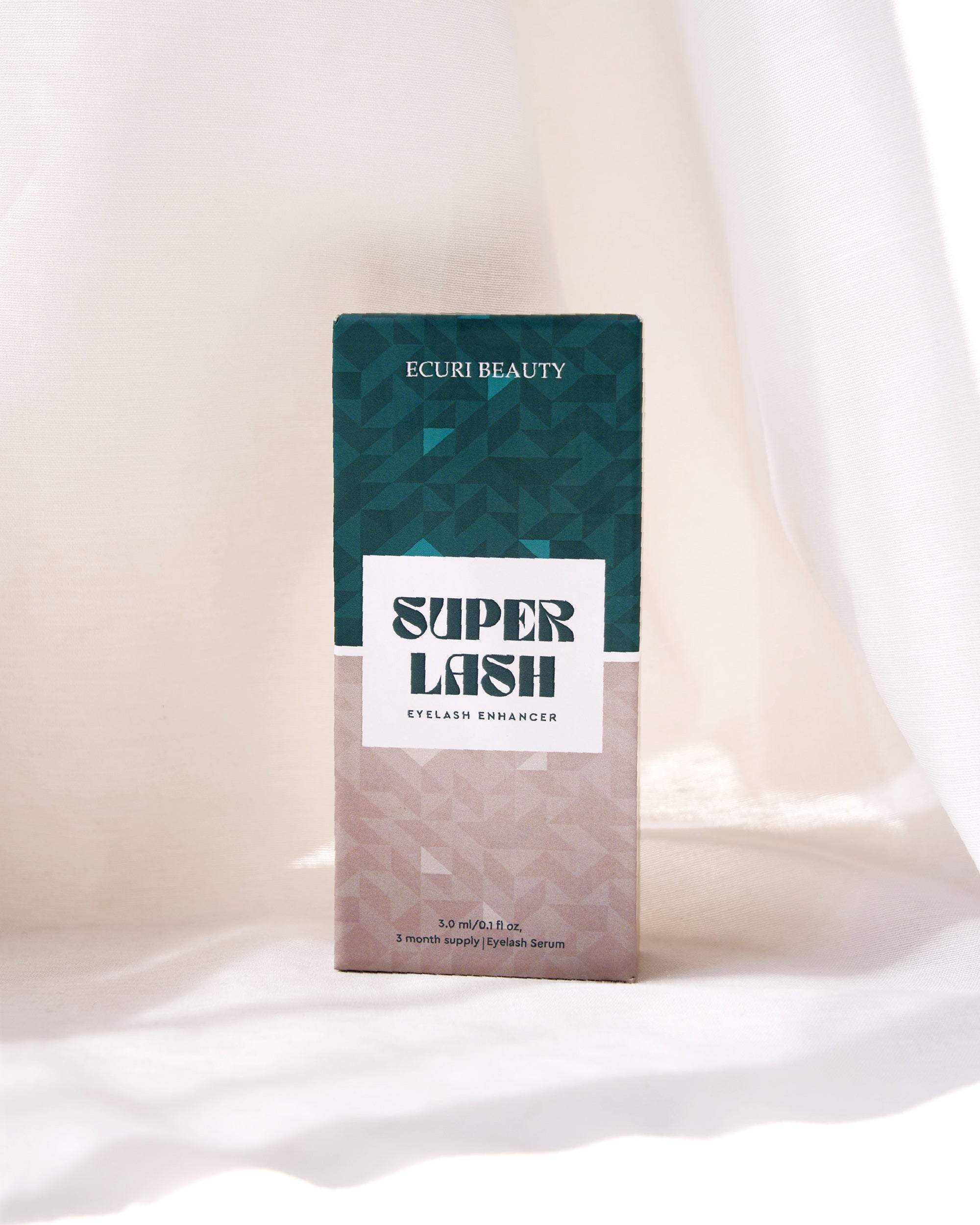Eyelash serum with Bimatoprost: Effect, safety and alternatives
More and more people are discovering the power of an eyelash serum containing bimatoprost for longer, fuller and darker lashes. But what exactly is bimatoprost? Why is it used in serums, and why is it sometimes labeled unsafe? In this blog we explain it to you step by step - with scientific evidence - and give you a safe and effective alternative: Ecuri Superlash.
In this article you will read about:
- What is bimatoprost
- How does an eyelash serum with bimatoprost work
- Why is the safety of bimatoprost sometimes questioned
- What does science say
- Which serums contain bimatoprost
- Ecuri Superlash: The Best Alternative without bimatoprost
Key take aways:
- Bimatoprost is a powerful ingredient in eyelash serums that has been proven to promote longer, fuller, and darker eyelashes.
- Although rare, side effects from bimatoprost may occur with improper use.
- Scientific studies confirm that bimatoprost is safe and effective when used topically for eyelash growth.
- Superlash is a safe alternative without bimatoprost, containing natural peptides, growth factors, and visible results within 4–6 weeks.
Wat is bimatoprost?
Bimatoprost is a synthetic prostaglandin analogue originally developed as a medication for glaucoma (increased eye pressure). During clinical trials, researchers found that patients got noticeably longer and fuller eyelashes as a side effect (Smith et al., 2009). This led to the cosmetic application of bimatoprost in eyelash serums, such as the well-known brand Latisse, which was the first to be approved by the FDA in 2008 for eyelash growth (FDA, 2008).
How does an eyelash serum with bimatoprost work?
Bimatoprost stimulates the anagen phase of the eyelash cycle – this is the active growth phase. This causes the eyelashes to grow:
- Longer because the growth phase is extended;
- Thicker because more hairs are in the growth phase at the same time;
- Darker due to increased pigment production.
The first visible results often appear after 4 to 8 weeks, with maximum effect after approximately 12 to 16 weeks (Glaser & Jones, 2010).
Why is the safety of bimatoprost sometimes questioned?
It is often claimed that bimatoprost is unsafe for cosmetic use. The most commonly cited concerns are:
- Discoloration of the skin around the eyes (periorbital hyperpigmentation)
- Eye irritation or itching
- Changes in iris color with prolonged use
However, these side effects are very rare and mainly occur with incorrect use or overdose. Many of these claims are based on experiences with eye drops (such as Lumigan), where the product is applied inside the eye – in contrast to the correct application of eyelash serum on the skin above the lash line (Chien et al., 2015).
What does science say?
Multiple clinical studies have confirmed the effectiveness and safety of bimatoprost as an eyelash enhancer:
- A large-scale study published in the Journal of the American Academy of Dermatology (Glaser & Jones, 2010) showed a significant increase in eyelash length, thickness, and color without serious side effects when used correctly.
- According to Smith et al. (2009), the effects of prostaglandin analogues on hair growth are convincing, and their cosmetic applications are well tolerated when used topically.
- The FDA approved Latisse in 2008 based on strictly controlled clinical data demonstrating its safety and effectiveness (FDA, 2008).
- A review article in the American Journal of Clinical Dermatology states that side effects are mainly mild and temporary, provided that the instructions are strictly followed (Chien et al., 2015).
- The conclusion? Bimatoprost is safe when used correctly and can produce impressive results (Abdelmaksoud et al., 2018).
The irony here is that bimatoprost is virtually the only ingredient considered to be an active substance in eyelash serums that has actually been tested and researched in the literature. So, any website can claim that other substances such as peptides, botanical extracts, and even other prostaglandin analogues are safe (or safer), but the fact remains that the only substance that has been thoroughly researched in the literature in terms of safety for eyelash lengthening is bimatoprost.
Which serums contain bimatoprost?
Although Latisse is the best-known brand, there are other eyelash serums containing bimatoprost or related prostaglandin analogues available. Some examples are:
- Careprost (India) – Widely used as an alternative to Latisse.
- Latisse – First FDA-approved medication for short eyelashes.
- Lumigan (off-label use) – Originally for glaucoma, but used as an eyelash serum.
- Old Kruidvat Superlash formula – Contained bimatoprost but has been taken off the shelves for several years
However, in many European countries, bimatoprost is only available on prescription, which limits its availability.
Ecuri Superlash: The Best Alternative without bimatoprost
Are you looking for a safe and effective alternative to an eyelash serum containing bimatoprost? Then Ecuri Superlash is an excellent choice.
Why Ecuri Superlash?
- Free from bimatoprost (contains a prostaglandin analogue as an alternative)
- Contains natural peptides and growth factors
- Suitable for daily use, even for sensitive eyes
- Visible results within 4-6 weeks
- Safe, even with prolonged use
Ecuri Superlash stimulates eyelash growth in a gentle, skin-friendly way – with peptides, growth factors, and a prostaglandin analogue working together for maximum results. This makes it ideal for people who want beautiful results without the possible side effects of bimatoprost.

Superlash eyelash serum
Discover the best alternative to eyelash serum containing bimatoprost.
In conclusion
An eyelash serum containing bimatoprost is a powerful and proven way to make your eyelashes fuller and longer. Although there are misconceptions about its safety, scientific research shows that when used correctly, it is an effective and safe cosmetic product.
Would you prefer an alternative without prostaglandins? Then Ecuri Superlash comes highly recommended. So you can enjoy beautiful lashes - in a natural, safe way.
Resources
- Smith, S., Fagien, S., Whitcup, S. M., & Swann, S. (2009). Prostaglandin analog effects on hair growth: A review and clinical applications. Dermatologic Surgery, 35(8), 1287–1300. https://doi.org/10.1111/j.1524-4725.2009.01226.x
- Glaser, D. A., & Jones, D. (2010). Efficacy and safety of bimatoprost in the treatment of hypotrichosis of the eyelashes. Journal of the American Academy of Dermatology, 62(6), 1013–1027. https://doi.org/10.1016/j.jaad.2009.07.025
- U.S. Food and Drug Administration (FDA). (2008). FDA Approves Latisse to Grow Eyelashes. https://www.fda.gov/news-events/press-announcements/fda-approves-latisse-grow-eyelashes
- Abdelmaksoud, A., et al. (2018). Bimatoprost in dermatology: Beyond glaucoma. Journal of Dermatological Treatment, 29(2), 142–148. https://doi.org/10.1080/09546634.2017.1343259
- Chien, A. L., Qi, J., & Cohen, B. A. (2015). Use of prostaglandin analogs in dermatology: An evidence-based review. American Journal of Clinical Dermatology, 16(5), 445–460. https://doi.org/10.1007/s40257-015-0147-7
Questions about Eyelash serums with bimatoprost?
After reading this article, do you have any questions about eyelash serums or eyelash serums containing bimatoprost? Or perhaps helpful tips for us and other eyelash serum users? Don't hesitate, we'd love to hear from you!


